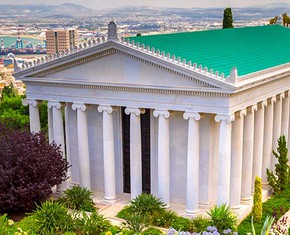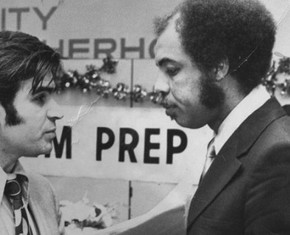The views expressed in our content reflect individual perspectives and do not represent the authoritative views of the Baha'i Faith.
In Lakota iconography, the Kapemni, in the shape of an upside-down tipi above a right-side-up tipi, their tops touching, represents inner reflection: “as above, so below.”
In this perspective, the physical world on Earth mirrors the heavens above—the material world reflects the spiritual world.
You can find that ancient wisdom in multiple places—in many Indigenous cultures, in science (the macrocosm reflects the microcosm) and even in the Lord’s Prayer: “Thy kingdom come, Thy will be done in earth, as it is in heaven.” – Mathew 6:10. The Baha’i teachings have an analogue:
… the outward is a reflection of the inward: The earthly realm is the mirror of the heavenly Kingdom, and the material world is in accordance with the spiritual world. – Abdu’l-Baha, Some Answered Questions, newly revised edition, p. 327.
I understand the Kapemni as a symbol of oneness—the oneness of God mirrored in the oneness of humanity, the light of God mirrored in our capacity as humans to reflect God’s essence.
Each of us has this capacity. We demonstrate it through acts of kindness, displays of patience, work for justice, moments of compassion, and expressions of gratitude. By recognizing this capacity and seeking out the light of God in one another, we can find oneness and stop “othering.”
Easier said than done, right? What else is required to connect with our neighbors? With our colleagues? With the stranger on the subway? With the person on the other side of an ideological wall? How do we overcome the prejudices that undermine oneness—prejudices rooted in suspicion, estrangement and fear?
A teenage girl named Emma Zurcher-Long, challenging societal judgments of autism, said: “Showing kindness towards those who are different and embracing our imperfections as proof of our humanness is the remedy for fear.”
So I’d like to suggest a simple, five-step process for getting beyond our prejudicial fears, which we all have, whether or not we are aware of them:
Step 1: Recognize and acknowledge our fears and implicit biases
Step 2: Push past our comfort zones and get exposure to what we fear or what we don’t know
Step 3: Ask questions (respectfully), and listen—and then keep listening.
Step 4: Open our hearts and show kindness
Step 5: Connect
I moved to New York City eight years ago, and throughout the years and all the conversations, I came to understand and experience that despite being a highly populated, diverse city, the city could be very isolating and segregated.
The psychological feat of traveling from one borough to another to see friends is unimaginable to many. In most neighborhoods, it’s not uncommon that you have never spoken to your neighbors. From lower Manhattan to Harlem and Meat Packing to Far Rockaway, the appearance, race and attire of passengers on the subway changes dramatically.
Despite the overall diversity across the five boroughs, the approximately 112,000 American Indians and Alaska Natives that live in New York City, the largest population of any urban area in the U.S., remain mostly invisible. Taking a particular interest in Indigenous peoples in my own city, and prompted by the Baha’i writings, I decided to take active steps to connect:
Attach great importance to the indigenous population of America. … should they be educated and guided, there can be no doubt that they will become so illumined as to enlighten the whole world. – Abdu’l-Baha, The Will and Testament, p. 33.
First I needed to acknowledge my own ignorance, open myself to learning, and develop friendships, recognizing that this would be a long-term process. So I took an Iroquois bead-working class at the American Indian Community House downtown, and signed up for a Wilmette Institute course on “Indigenous Perspectives of the Sacred.”
Initially, the course asked us to take Harvard University’s implicit bias test. What an incredible tool, with such broad application! (You can find it here: https://implicit.harvard.edu/implicit/takeatest.html)
The results of the test showed me that we’ve been conditioned to fear what’s different through biased media and inherited trauma, etc. Those implicit biases can corrode our hearts. But when I acknowledge these fears and biases, two things happen. First, I can check myself—every thought, every action. I can consciously ask myself, where does this feeling come from? Then, I can give myself the opportunity to make a choice—to act from love rather than fear.
Secondly, recognizing any implicit biases I may have empowers me to move beyond my comfort zone in search of the truth, so my reality can be shaped by my experience of the truth rather than a distorted perception of it.
In a continued effort to connect and become an ally, I attended Native American powwows in the city, including the First United Lenape Nations Pow Wow, a significant gathering of the people of the Lenape Diaspora for the first time since they were forced north to Canada and south to Oklahoma in the 1700s. The experience was overwhelmingly moving—including the dancing that painted shapes and colors in the air to the beat of the drums, which represented the heartbeat of Mother Earth that connects us all. The singing gave wings to prayer and brought a river of tears down my cheeks as I recalled the stories of the residential schools, the Long Walk, the deep generational wounds that have been inflicted on a beautiful people.
As we search for oneness, we must open our eyes to the light of God in everyone. We must open our hearts, unbind them from the shackles of prejudice, and listen—listen earnestly and with humility. Sometimes, this means letting in someone else’s pain—feeling through it and understanding it—so, hand in hand, we can take steps to heal it.
You May Also Like
Comments

















― Charles Eisenstein, The More Beautiful World Our Hearts Know Is Possible